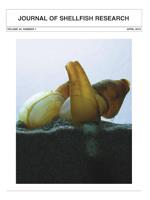Thirty adult organisms of Panopea globosa, an endemic geoduck species from Baja California, Mexico, were collected monthly during a maturation cycle (October through January). Histological and semiquantitative histochemical changes (total lipids and carbohydrates) were assessed in gonad tissue during the maturation process. Biochemical quantification of proteins, lipids, carbohydrates, vitellogenin, and vitellin was performed on hemolymph and gonad tissues of all specimens. The theoretical diameter of oocytes was also estimated from their surface area, measured in histological sections of gonads. Five distinct gonadal stages were identified in both male and female geoducks, with previtellogenic (PVt)/early spermatogenic (ES) gonads being observed in October. Spawning took place in December/January when the temperature reached a plateau of ∼18.5°C. Oocyte diameter varied between 25.5 µm(PVt stage) and 74.8 µm during the late vitellogenic stage (LVt). The percent of lipids and carbohydrates evaluated histochemically in females closely mirrored the gonadal stages, as well as the diameter. Quantitative changes in proteins, lipids, and carbohydrates in the hemolymph did not show a clear temporal pattern, yet the level of vitellogenin increased from 16.4 (PVt stage)—47.8 µg/mL (LVt stage) and correlated with the oocyte diameter. The weightspecific content of proteins, lipids, and carbohydrates in the gonads was significantly greater during PVt and ES than the other gonadal stages, and remained relatively constant thereafter. Vitellin content mirrored the evolution of each maturation stage and correlated significantly with oocyte diameter. Vitellogenin or vitellin can be used as a reliable quantitative index of gender and degree of gonadic maturity in females. Hemolymph can be obtained readily from the pericardial cavity without affecting the performance of the organism significantly, which further makes vitellogenin a valuable, nonlethal marker for this genus.
How to translate text using browser tools
1 March 2015
Biochemical And Histochemical Changes Associated with Gonad Development of the Cortez Geoduck, Panopea globosa (Dall 1898), from the Gulf of California, Mexico
Fabiola G. Arcos-Ortega,
Santiago J. Sánchez León-Hing,
Carmen Rodriguez-Jaramillo,
Mario A. Burgos-Aceves,
Ivone Giffard-Mena,
Zaul García-Esquivel
ACCESS THE FULL ARTICLE

Journal of Shellfish Research
Vol. 34 • No. 1
March 2015
Vol. 34 • No. 1
March 2015
biochemistry
geoduck
Histochemistry
Panopea globosa
reproduction
vitellogenin




